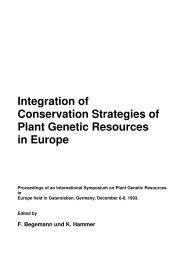Agrobiodiversität in Deutschland - Genres
Agrobiodiversität in Deutschland - Genres
Agrobiodiversität in Deutschland - Genres
Sie wollen auch ein ePaper? Erhöhen Sie die Reichweite Ihrer Titel.
YUMPU macht aus Druck-PDFs automatisch weboptimierte ePaper, die Google liebt.
26 | Johannes Engels<br />
From the earliest conservation and use activities<br />
of genetic resources until today<br />
facilitated by his scientific m<strong>in</strong>d, certa<strong>in</strong>ly with respect to understand<strong>in</strong>g<br />
diversity and to contribute to its classification, can be measured aga<strong>in</strong>st the<br />
fact that Charles Darw<strong>in</strong> had high appreciation for the work of von Humboldt.<br />
It had helped Darw<strong>in</strong> tremendously with his own studies (Wikipedia/<br />
von Humboldt 2011). Based on these and many other facts and figures one<br />
can conclude that von Humboldt has significantly contributed to our understand<strong>in</strong>g<br />
of biological diversity, of the classification of plants and animals,<br />
their distribution and that this would not have been possible without<br />
mov<strong>in</strong>g these resources from where they were collected <strong>in</strong> Lat<strong>in</strong> America<br />
to Europe. Even aga<strong>in</strong>st ‘modern legislation’ with respect to the availability<br />
of genetic resources and their subsequent use for research von Humboldt<br />
does not ‘qualify’ as a biopirate, <strong>in</strong> fact he was and is a highly respected and<br />
esteemed bio-scientist!<br />
Another important and famous European collector has been Nicolay<br />
Vavilov (1887-1943). He collected worldwide as much genetic diversity of<br />
many crops, especially those that would have a potential to grow under<br />
temperate conditions, <strong>in</strong> search for diversity that would allow expansion<br />
of agriculture <strong>in</strong>to Siberia through actual breed<strong>in</strong>g. Most of the collected<br />
material (more than 200.000 seed and root samples (http://en.wikipedia.org/<br />
wiki/Nikolai_Vavilov, visited on 27.12.2011) was brought back to St. Petersburg<br />
(then the All-Union Institute of Agricultural Sciences at Len<strong>in</strong>grad),<br />
grown out <strong>in</strong> fields, evaluated and then stored under ambient conditions, at<br />
the now called ‘N.I. Vavilov Research Institute of Plant Industry’ at St. Petersburg<br />
or at its 11 research stations spread across Russia (http://vir.nw.ru/<br />
structure.htm, consulted on 27.12.2011). Vavilov systematically analysed the<br />
species and genetic diversity while collect<strong>in</strong>g and afterwards <strong>in</strong> the experimental<br />
fields at home. That allowed him to develop his theory on the centres<br />
of orig<strong>in</strong>, i.e. geographical areas where a group of plants, either domesticated<br />
or wild, first developed its dist<strong>in</strong>ctive properties (see also Figure 2). A centre<br />
of orig<strong>in</strong> frequently co<strong>in</strong>cides with a centre of diversity, i.e. a geographical<br />
area where a given species or genus had developed a significant high level of<br />
genetic variation. By br<strong>in</strong>g<strong>in</strong>g the genetic diversity of cultivated crops (and<br />
some of their wild relatives) to one <strong>in</strong>stitution Vavilov established one of the<br />
first genebanks. As was already mentioned for von Humboldt, these significant<br />
research efforts with a critical important impact on the understand<strong>in</strong>g<br />
and conservation of plant genetic resources would have most likely not hap-<br />
pened if legal restrictions of access<strong>in</strong>g genetic resources would have been<br />
<strong>in</strong> place dur<strong>in</strong>g that period. Therefore, it can also be concluded that Vavilov<br />
was not a biopirate. Ironically, dur<strong>in</strong>g the partly occupation of the Soviet<br />
Union a special commando of Hitler’s regime took germplasm collections<br />
but failed to access the seed collection <strong>in</strong> St. Petersburg (http://en.wikipedia.<br />
org/wiki/Nikolai_Vavilov). This latter act could be classified as biopiracy.<br />
Fig. 2: The centres of diversity of cultivated plants. (1) Mexico-Guatemala, (2) Peru-Ecuador-Bolivia, (2A)<br />
Southern Chile, (2B) Southern Brazil, (3) Mediterranean, (4) Middle East, (5) Ethiopia, (6) Central Asia,<br />
(7) Indo-Burma, (7A) Siam-Malaya-Java, (8) Ch<strong>in</strong>a (adapted from Ladiz<strong>in</strong>ski 1998).<br />
Abb. 2: Die Diversitätszentren der Kulturpflanzen. (1) Mexiko-Guatemala, (2) Peru-Ecuador-Bolivien, (2A) Süd-<br />
Chile, (2B) Süd-Brasilien, (3) Mittelmeerraum, (4) Mittlerer Osten, (5) Äthiopien, (6) Zentralasien, (7) Indo-<br />
Burma, (7A) Siam-Malaysia-Java, (8) Ch<strong>in</strong>a (nach Ladiz<strong>in</strong>ski 1998).<br />
Breed<strong>in</strong>g and genetic resources<br />
The discovery of Mendel’s <strong>in</strong>heritance laws around 1865 greatly facilitated<br />
the step from farmers’ and hobby breed<strong>in</strong>g to professional plant breed<strong>in</strong>g.<br />
Specially <strong>in</strong> central Europe a number of breed<strong>in</strong>g ‘companies’ started with<br />
well-def<strong>in</strong>ed programmes to breed major crops. This resulted <strong>in</strong> an <strong>in</strong>creas<strong>in</strong>g<br />
need for more and specific genetic diversity, as illustrated above with<br />
the efforts that Vavilov undertook a few decennia later. Such efforts of accumulat<strong>in</strong>g<br />
more genetic diversity through exchange and targeted collect-<br />
Johannes Engels | 27










